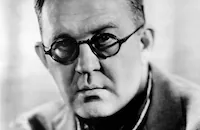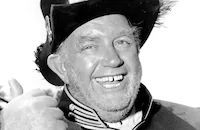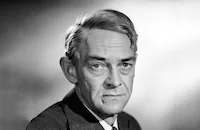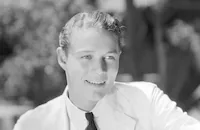Two Rode Together

Brief Synopsis
Cast & Crew
John Ford
James Stewart
Richard Widmark
Shirley Jones
Linda Cristal
Andy Devine
Film Details
Technical Specs

Synopsis
In the 1880's, Guthrie McCabe, a cynical, mercenary Texas marshal, is asked to join cavalry officer Jim Gary in rescuing some white prisoners long held captive by the Comanches. McCabe is reluctant to accept but allows himself to be persuaded by a combination of Army pressure, the offer of a salary, the promise of a fee for each captive returned, and the opportunity to take a vacation from Belle Aragon, a saloon owner who has marriage on her mind. In exchange for two rifles, McCabe and Gary obtain the release of Running Wolf, a white boy raised as an Indian, and Elena, a young Mexican woman who has been forced to become the squaw of Comanche warrior Stone Calf. As the little group leaves the Indian camp, Stone Calf tries to reclaim his woman, and McCabe kills him. Back at the fort, none of the families who anxiously awaited the return of their relatives recognize Running Wolf, and he is claimed only by the mentally deranged Mrs. McCandless, who insists the wild boy is her son. However, as she frees him of his bonds, he murders her. The inflamed settlers capture and lynch the youth, but before he dies it is discovered that he is actually the brother of Marty Purcell, a young settler with whom Gary has fallen in love. Meanwhile, Elena has been shunned by the narrow-minded officers' wives. McCabe leaves the fort to resume his marshal's job and discovers that he has been replaced by his inept deputy in the interim. Disenchanted, he rides off with Elena in search of a better life.

Director

John Ford
Cast

James Stewart

Richard Widmark

Shirley Jones

Linda Cristal

Andy Devine

John Mcintire
Paul Birch

Willis Bouchey

Henry Brandon

Harry Carey Jr.
Olive Carey

Ken Curtis
Chet Douglas
Annelle Hayes
David Kent

Anna Lee
Jeanette Nolan

John Qualen
Ford Rainey

Woody Strode
O. Z. Whitehead
Cliff Lyons

Mae Marsh
Frank Baker
Ruth Clifford
Ted Knight
Major Sam Harris
Jack Pennick
Chuck Roberson
Dan Borzage

Bill Henry
Chuck Hayward

Edward Brophy
Crew
James M. Crowe
George Duning
John Ford
Ben Lane
Charles Lawton Jr.
Harry Mills
Arthur Morton
Jack Murray
Frank Nugent
Robert Peterson
Charles J. Rice
Stan Shpetner
Wingate Smith

Photo Collections
Videos
Movie Clip




Film Details
Technical Specs

Articles
Two Rode Together on Blu-ray
Screenwriter Frank S. Nugent tackles a near-replay of major themes from John Ford's The Searchers, on a smaller scale. Corrupt Marshal Guthrie McCabe (James Stewart) skims 10% of all business in Tascosa, and spends most of his time drinking beer on the porch of the bar/brothel owned by Belle Aragon (Annelle Hayes). Then he's roped into accompanying Cavalry Lt. Jim Gary (Richard Widmark) to negotiate with the Comanche Chief Quanah Parker (Henry Brandon) for the return of white captives. In hopes of recovering their stolen children, a sizeable group of families has encamped at the fort of Major Frazer (John McIntire). Frazer has unrealistic ideas of the odds of success, and the civilians likewise expect their lost family members to magically return as they once were. To Jim's consternation, Guthrie brings a stock of rifles along, to insure that Quanah Parker will trade. Quanah gives up three captives. "Wakanana" (Regina Carrol) prefers to stay with her Indian husband. McCabe must tie a violent white teenager now known as Running Wolf (David Kent) to his saddle. Guthrie takes him because he's made a lucrative deal with one of the civilians, McCandless (stunt director Cliff Lyons). The man will accept any captive boy to make his heartbroken wife Mary (Jeanette Nolan) happy. The third captive is a Mexican señora, Elena de la Madriaga (Linda Cristal). She's married to Stone Calf (Woody Strode), a warrior who challenges Quanah Parker's leadership. Parker purposely hands Elena over in the hope that the sharpshooting Guthrie will rid him of Stone Calf.
John Ford's impressive pictorial style in The Searchers made the West look pure, as if sanctified by heaven. Although Charles Lawton Jr.'s cinematography is attractive, this may be Ford's first western not to exploit striking exterior landscape compositions. Most of the film's interiors are shot in static wide masters suitable for a silent movie, as if Ford were too lazy or tired to direct for the camera. This works well enough when the actors are lively and the slightly cynical script is in good humor. Yet the camera almost invariably faces one way, with the actors arrayed as if on a stage.
Ford doesn't alter this formula even in the film's most violent moments. In the film's most tense confrontation, a menacing Indian warrior walks almost casually into the frame, and is shot down. A tragic lynching scene uses only three or four angles (plus cutaway close-ups) to show a mob dragging its victim past a wagon on the way to the hanging tree. Everything cuts, but Ford seems to be relying on George Duning's music to generate excitement.
Ford's simplified direction may have been an economic necessity. By the middle 1950s he had fairly used up the possibilities of his beloved Monument Valley, so we don't mind that this show is not yet another epic dominated by that strange landscape. Stewart and Widmark's fees could very well have accounted for the bulk of the film's budget, ruling out distant locations. In interviews about 'Pappy' Ford, James Stewart implied that he was the meek actor in the presence of the master director. But we can see that the actor is carrying much of the picture. Resting by a creek-side, Stewart and Richard Widmark carry on a loose conversation that goes on for perhaps three full minutes. It stops only when the actors finally run out of lines to improvise. The camera remains stock-still.
On a character level Two Rode Together is frequently very rewarding. Having graduated from his Anthony Mann 'neurotic hero' westerns, Stewart's Marshal is an amusingly thorough opportunist, throwing his weight around Tascosa and making money while lounging on a porch chair. Belle Aragon apparently sleeps with him at her pleasure and carries a knife on her thigh to keep him in line. With zero interest in doing anything for free, McCabe takes on the rescue mission only when a civilian promises him a bonus of a thousand dollars. Stewart gets exactly one 'Anthony Mann' moment when he draws his pistol on Richard Widmark. The scene tries to provide some sense of character tension, but it's almost a throwaway.
The Searchers impressed audiences with its acknowledgment of racial prejudice. Two Rode Together makes white bigotry its main concern. The Indians may be rough on their captives but they form relationships equally as solid as those in the white community. The attempts to return the captives result in failure or tragedy. The blonde Kristin refuses to go, and remains in the tribe, as Wakanana. The only thing to do is to lie to her father, the forlorn Ole Knudsen (permanent Ford fixture John Qualen). Running Wolf has dropped any trace of his white identity, and poses an obvious menace to the civilians back in the camp. Audiences in 1961 would have related to the character as an even more dangerous variety of teenage delinquent. Elena Madriaga rather unaccountably accepts the fate of her beloved Comanche husband and voluntarily returns, only to bear the brunt of white prejudice and cruelty back at the fort. Because she has been 'defiled' by a savage, she's no longer socially acceptable on any level. Jim and Guthrie take turns lecturing the bigots and biddies at the fort, but their words have no measurable effect.
Guthrie McCabe is drawn to Elena, while Jim "goes soft" on the young and spirited Mary Purcell (Shirley Jones), who had hoped to be reunited with her long-lost brother. Their courtship is handled in annoying Ford nonsense fashion, with a tough 40+ cavalry officer acting like as shy as a ten-year-old. There's also a clownish fistfight between Jim and the moronic Clegg Brothers Ortho and Greeley (Ford players Harry Carey Jr. & Ken Curtis). We much prefer Stewart's semi-comic relationship with the humorless Belle Aragon, who isn't about to let sentiment enter the picture, not for a moment.
Although Ford frequently expressed sympathy for minorities, his depiction of them never really changed much. As in The Searchers, Anglo actor Henry Brandon once again draws Heap Big Injun Chief duty. But this time he's equally as conniving as his white counterparts. Quanah Parker sneers at Stone Calf for believing that a foolish religious shield ceremony can offer protection from the white man's bullets. Black acting icon Woody Strode takes a demotion from his leading role in Sgt.Rutledge, but we're given to understand that members of Ford's stock company were expected to accept any role he offered them. Strode plays a Native American here, and would later play a Chinese bandit in Seven Women.
Other Ford stock company players are Olive Carey, Harry Carey Jr., Ken Curtis, Anna Lee and O.Z. Whitehead. "Emeritus" Ford actress Mae Marsh appears as a loony old white captive. The star of the original Birth of a Nation makes a strong impression despite being seen in exactly one shot. The husband & wife acting team of John McIntire and Jeanette Nolan have featured roles; Ms. Nolan's frantic Mrs. McCandless is the most sympathetic of the settlers desperate to recover lost children.
Recent Oscar winner Shirley Jones receives preferred billing but hasn't a particularly rewarding role. In her one really memorable scene, what sticks with us is not Ms. Jones, but the horrifying meaning of a fancy music box. Leading lady honors go to Argentine beauty Linda Cristal, as the Mexican woman 'of good family' newly returned from the Indian camp. Ford allows Elena some worthy close-up reactions before having her break down emotionally. Elena gravitates toward strong men - first Stone Calf and now Guthrie McCabe.
The film makes a big point of the fact that the biddies at the fort consider Elena's presence an obscene scandal, when she is obviously a lady of quality. This simplified view doesn't take into account that the fort's mostly Irish American immigrants would most likely discriminate against Elena just for being Mexican. For that matter, higher Mexican society might reject Elena as well, as racial and class discrimination would arguably be even more pronounced South of the border. Ford insists on characterizing Elena as a delicate, sheltered princess, despite having lived for several years as the woman of a Comanche warrior. A more 'evolved' Latina character appeared a decade earlier, in Fred Zinnemann's The Man Who Shot Liberty Valance.
The Twilight Time Blu-ray of Two Rode Together is a good reminder of how attractive this picture can look in a proper presentation. Cinematographer Charles Lawton Jr.'s taste and discretion makes Ford's simple choice of shots look their best. The movie's many wide master shots did not fare well in old television screenings because the unmasked 1:33 prints marooned the actors as tiny figures, with acres of headroom above and foot room below. Until I saw Two Rode Together on a big screen I thought that Running Wolf had been played by Sal Mineo. The actor's face was always so small in the frame.
Twilight Time's presentation gives us an Isolated Score Track in which Columbia house composer George Duning provides excellent counterpoint to Ford's direction. The original trailer argues that fans that want real western adventure should forget the tiny B&W TV fare and instead take in the big screen impact of the colorful Two Rode Together. Julie Kirgo's thoughtful liner notes provide career context for what became a lesser Ford picture, and sharp insights into the way the film breaks down Ford's tenets of family solidarity.
By Glenn Erickson

Two Rode Together on Blu-ray
Two Rode Together
Although this first pairing of James Stewart and director John Ford may have been cause for cinematic celebration, it wasn't a happy shoot. This was not a personal project for Ford but something he did only for the money ($225,000 plus 25 percent net profits) and as a favor to Columbia Pictures head Harry Cohn, a man Ford said he admired like "a large, brilliant serpent." The director hated the material, believing he had done a far better treatment of the theme in The Searchers (1956). Even after he brought in his most trusted screenwriter, Frank Nugent - the man responsible for The Searchers and nine other Ford classics - to fix the script, the director said it was "still crap." Nevertheless, he took the project on and proceeded to take his frustrations about it out on his cast and crew. Not that this was uncharacteristic. Stewart had been warned about the director's behavior by such longtime Ford stalwarts as John Wayne and Henry Fonda (who Ford once socked in the jaw during the filming of Mister Roberts, 1955). Stewart came to learn Ford liked to keep his actors in the dark about the direction of the picture and suspicious of each other. In Andrew Sinclair's biography, John Ford, Stewart revealed that Ford's "direction took the form of asides. Sometimes he'd put his hand across his mouth so that others couldn't hear what he was saying to you. On Two Rode Together he told me to watch out for Dick Widmark because he was a good actor and that he would start stealing if I didn't watch him. Later, I learned he'd told Dick the same thing about me. He liked things to be tense."
One of the film's most renowned and impressive shots has been credited solely to Ford's mean streak. In the famous five-minute two-shot of Stewart and Widmark bantering on a river bank about money, women, and the Comanche problem, the film's downbeat comedy, misogyny, and careless attitude toward human life are summed up perfectly. Ford justified the take as a simple preference for a wide-screen two-shot over cross-cutting between close-ups of "pock-marked faces." But Stewart and others insisted Ford was so cantankerous during production he forced his crew to wade waist-deep into the icy river and stay there all day until the shot was completed.
Whether the product of a bad attitude or a shift in artistic vision, Two Rode Together is Ford's most irredeemably cynical movie and ends in complete disillusionment. In many of his classics, such as My Darling Clementine (1946), the town, while representative of the encroachment of civilization on the rugged individualism of the West, is nevertheless seen as a place of family, law, and community. In this picture, the town is all about corruption without any of the mythologized virtues Ford brought to his earlier works. In contrast to Henry Fonda's self-sacrificing Wyatt Earp, Stewart's McCabe is little more than a mercenary, up to his ears in graft. Even the director's characteristic town dance sequence is used to different effect. In My Darling Clementine it celebrates the civilizing qualities of community. In Two Rode Together it is used to highlight and attack the townspeople's intolerance and hypocrisy, as Stewart rails against them for treating the Linda Cristal character even worse than her former captors.
Although the movie was not a commercial success and Stewart and Ford did not make the best collaborative team, there must have been something in this bleaker revisionist view of the West that appealed to both men. Stewart would work for the director three more times, two of those in films that took a radically different and even darker view of the western myth - The Man Who Shot Liberty Valance (1962) and Cheyenne Autumn (1964). They might not have been the best of friends on-and-off the set but they had a grudging respect for each other and the closest Ford ever came to praising Stewart was when he said, "He did a whale of a job manufacturing a character the public went for. He studied acting."
Producer: John Ford, Stanley Shpetner
Director: John Ford
Screenplay: Frank Nugent, from the novel Comanche Captives by Will Cook
Cinematography: Charles Lawton Jr.
Editing: Jack Murray
Art Direction: Robert Peterson
Original Music: George Duning
Cast: James Stewart (Marshall Guthrie McCabe), Richard Widmark (Lt. Jim Gary), Shirley Jones (Marty Purcell), Linda Cristal (Elena de la Madriaga), Andy Devine (Sgt. Darius Posey), John McIntire (Major Frazer), Paul Birch (Judge Edward Purcell), Henry Brandon (Chief Quanah Parker), Harry Carey, Jr. (Ortho Clegg), Ken Curtis (Greeley Clegg), Jeanette Nolan (Mrs. Mary McCandless), Woody Strode (Stone Calf).
C-109m.
by Rob Nixon
Two Rode Together
Quotes
You! You're supposed to be dead!- Sergeant Darius P. Posey
I'm sorry, Slim. I didn't quite make it.- Marshal Guthrie McCabe
Trivia
Notes
Filmed on location in southwestern Texas.

Miscellaneous Notes
Released in United States Summer July 1961
Released in United States Summer July 1961













